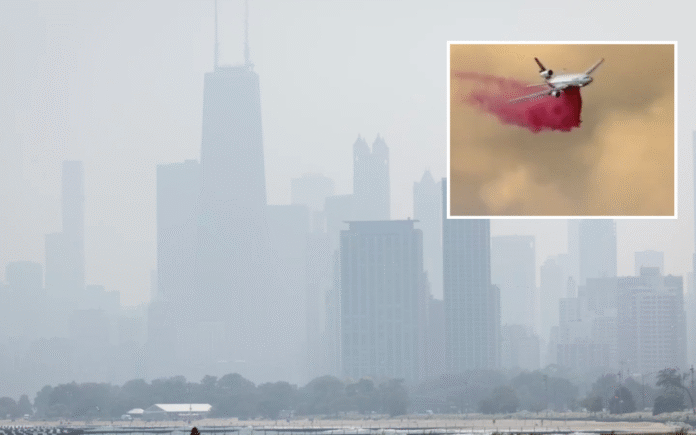Key Point Summary – Canada Fire Smoke chokes US
- Wildfire smoke from Canada floods the US Midwest and Northeast
- Air quality alerts issued in more than seven states over the weekend
- Millions advised to stay indoors as haze blankets major US cities
- Experts warn of long-term health risks from repeated smoke exposure
- Residents lash out over growing inaction and recurring smoke events
- Weather patterns continue driving Canadian smoke across the border
- Canada fire smoke chokes US skies again—thick, dangerous, and spreading
Midwest Gasping For Air As Smoke Returns
It’s back—thicker, darker, and more dangerous than before.
Over the weekend, a heavy wave of wildfire smoke from Canada poured into the United States, blanketing vast swaths of the Midwest and Northeast. States from Minnesota to Maine woke up under a hazy dome that dimmed the sun and triggered health alerts.
The source? Thousands of wildfires burning across Canada in one of its worst fire seasons in history. Winds carried the toxic haze southward, dumping it straight onto American cities—yet again.
Cities Across The Midwest Hit Pollution Red Zone
Chicago looked like a dystopian postcard. Milwaukee vanished into gray. Even Detroit, hundreds of miles away from the flames, issued warnings.
The smoke didn’t creep in—it surged. Visibility dropped. Skies turned an eerie yellow. The air smelled of ash and ozone. Most importantly, the numbers backed it up: air quality index readings surged into the “Unhealthy” and “Very Unhealthy” categories by Saturday afternoon.
Officials across Illinois, Michigan, Wisconsin, Indiana, and Ohio scrambled to warn residents. Schools canceled outdoor activities. Doctors urged people to close windows, wear N95 masks, and avoid exercise.
Northeast Joins The Haze Crisis
Meanwhile, the Northeast didn’t escape the chokehold. In New York, Vermont, New Hampshire, and parts of Massachusetts, residents also faced air thick with soot. By Sunday, multiple counties saw air quality alerts go into effect as the haze drifted eastward.
In rural towns and big cities alike, the story was the same: gritty eyes, scratchy throats, and a rising sense of dread.
Public Rage Boils Over Amid “Smoke Season”
For many, this felt like déjà vu. And the anger boiled over.
“We’ve had more smoke days this year than snow days,” a frustrated mother in Madison, Wisconsin posted on social media. “What am I supposed to tell my kids—stay inside all summer?”
Others questioned whether the government is doing enough. “This isn’t a one-time emergency anymore,” wrote one New York doctor. “It’s smoke season. Where’s the plan?”
Protests have already begun forming in parts of Michigan and New Jersey, with residents calling for federal pressure on Canada to control their wildfire outbreaks and invest in suppression technologies.
Weather Patterns Keep The Smoke Coming
Meteorologists say this is far from over.
Strong upper-level winds continue pulling Canadian smoke deep into the U.S. The National Weather Service warns that until rain falls on Canada’s burning forests—or the wind shifts—millions more Americans will keep breathing wildfire pollution.
And the science is grim. According to health experts, repeated exposure to wildfire smoke—even from a distance—can lead to long-term respiratory problems, increased risk of stroke, and premature death in vulnerable groups.
Canada Fire Smoke Chokes US—And It’s Getting Worse
This isn’t just about one bad weekend. It’s about a trend.
Canada has already logged nearly 4,000 wildfires this year. The scale and intensity have overwhelmed fire crews. With hotter temperatures, drier forests, and less snowmelt, the conditions are ripe for record-breaking blazes.
And when those forests burn, Americans suffer. The smoke travels freely across the border, settling over the Midwest and Northeast like a slow, silent attack.
Outlook: Another Week Of Smoke, Uncertainty, And Frustration
Forecasters say the smoke will likely persist into the new week, especially in regions downwind of Ontario and Quebec. While some areas may see temporary improvement, any new flare-ups in Canada could reset the clock.
Air quality alerts are expected to remain in effect in at least eight states through midweek. Schools, summer camps, and sports events may face additional cancellations.
And still, the smoke keeps coming.
Unless massive wildfires in Canada slow down—or international cooperation kicks in—this could be the new normal for summers in the northern U.S.
Once again, Canada fire smoke chokes US skies. And this time, Americans are fed up.




